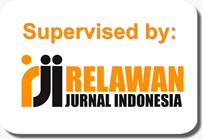THE EFFECT OF WORK MOTIVATION AND WORK DISCIPLINE ON EMPLOYEE PERFORMANCE WITH REWARD AND PUNISHMENT AS MODERATION VARIABLES (CASE STUDY : PT SALIM IVOMAS PRATAMA KOTA PEKANBARU)
Abstract
The era of globalization where every company must compete to maintain and develop its existence, including PT Salim Ivomas Pratama. The main activities of PT Salim Ivomas Pratama start from research, seeding, processing to marketing, the complexity of all activities at PT Salim Ivomas Pratama must be supported by qualified employees and good human resource management. . One of the important elements to improve employee performance is motivation and work discipline. While the reward and punishment system plays a role in maintaining the motivation of high-performing employees. The study aims to determine the effect of work motivation and work discipline on employee performance with reward and punishment as mediation variables. Quantitative research using SEM-PLS analysis with the help of SmartPLS application version 3.0. The research instrument was in the form of a questionnaire with a total of 132 respondents. The results of the study found that reward and punishment variables mediate work motivation variables on employee performance by providing a positive and significant influence shown through calculated values of 2.441< 1,979 tables and p-values of 0.015 < 0.05. Furthermore, reward and punishment can mediate between the variability of work discipline on employee performance positively and significantly indicated by a calculated value of 4.323< 1,979 ttable and p-value 0.000< 0.05
Keyword: Work Motivation, Work Discipline, Employee Performance and Reward And Punishment
Full Text:
PDFReferences
Adha, R. N., Qomariah, N., & Hafidzi, A. H. (2019). Pengaruh motivasi kerja, lingkungan kerja, budaya kerja terhadap kinerja karyawan dinas sosial kabupaten Jember. Jurnal Penelitian IPTEKS, 4(1), 47–62.
Dymastara, E. S., & Onsardi, O. (2020). Analisis Reward Dan Punishment Terhadap Kinerja Karyawan Pt. Sandabi Indah Lestari Bengkulu Utara. Jurnal Entrepreneur Dan Manajemen Sains (JEMS), 1(2), 160–167.
Ferawati, A. (2017). Pengaruh lingkungan kerja dan disiplin kerja terhadap kinerja karyawan. Agora, 5(1), 160–167.
Hanaysha, J. (2016). Examining the Effects of Employee Empowerment, Teamwork, and Employee Training on Organizational Commitment. Procedia. Social and Behavioral Science, 229, 298–306. https://doi.org/https://doi.org/10.1016/j.sbspro.2016.07.140
Harcang, Guntur, M., Herman, & Niswaty, R. (2021). The Effect of Work Discipline and Career Development on the Work Productivity of Employees at the Education Office and the Culture of Wajo District. Jurnal Administrare: Jurnal Pemikiran Ilmiah Dan Pendidikan Administrasi Perkantoran, 8(1), 255–262.
Ivancevich, Konopaske, & Matteson. (2006). Perilaku Manajemen Dan Organisasi. alih bahasa Gina Gania. Erlangga.
Jufrizen, & Hadi, F. . (2021). Pengaruh fasilitas kerja dan disiplin kerja terhadap kinerja karyawan melalui motivasi kerja. Sains Manajemen: Jurnal Manajemen Unsera, 7(1), 35–54.
Juliandi, A. (2018). Structural Equation Model Partial Least Square (Sem-Pls) Dengan SmartPLS. Modul Pelatihan, 1-4.
Lusri, L., & Siagian, H. (2017). Pengaruh motivasi kerja terhadap kinerja karyawan melalui kepuasan kerja sebagai variabel mediasi pada karyawan PT. Borwita Citra Prima Surabaya. Agora, 5(1).
Muna, N., & Isnowati, S. (2022). Pengaruh Disiplin Kerja, Motivasi Kerja, Dan Pengembangan Karir Terhadap Kinerja Karyawan (Studi pada PT LKM Demak Sejahtera). Jesya (Jurnal Ekonomi Dan Ekonomi Syariah), 5(2), 1119–1130.
Nurlaely, Djunaedi, Septyaningtyas, D. R., & Alamsyah, M. F. A. (2022). The Role of Work Discipline as an Intervening Variable in the Relationship Between Work Environment, Work Motivation and Employee Performance. American International Journal of Business Management (AIJBM), 5(12), 70–78.
Panjaitan, F. A. B. K., & Panjaitan, H. (2021). Customer value is reviewed in terms of customer relationship learning and customer engagement: Evidence from banking industry. Accounting, 7(1), 89–94.
Sholiha, E. U. N., & Salamah, M. (2015). Structural equation modeling-partial least square untuk pemodelan derajat kesehatan kabupaten/kota di Jawa Timur (studi kasus data indeks pembangunan kesehatan masyarakat Jawa Timur 2013). Jurnal Sains Dan Seni ITS, 4(2), 169–174.
Sitoresmi, A. R. (2022). Profil PT Salim Ivomas Pratama, Sejarah, Nilai-Nilai, Anak Perusahaan dan Produknya. Liputan6. https://www.liputan6.com/hot/read/5163946/profil-pt-salim-ivomas-pratama-sejarah-nilai-nilai-anak-perusahaan-dan-produknya
Vallennia, K., Atikah, A., & Azijah, F. N. (2020). Pengaruh Disiplin Kerja Terhadap Kinerja Karyawan:(Studi Kasus PT. SINAR SOSRO Rancaekek). E-Jurnal Equilibrium Manajemen, 6(2), 39–49.
Veithzal, R. (2005). Manajemen Sumber Daya Manusia Untuk Perusahaan. PT. Raja Grafindo Persada.
Vinzi, V. E., Chin, W. W., Henseler, J., & Wang, H. (2010). Handbook of Partial Least Squares. Springer.
Wibisono, A., Anwar, M., & Kirono, I. (2015). Stuctural Equation Modeling Partial Least Square (Sem Pls) Untuk Mengetahui Kinerja Karyawan Pada Pt. Dempo Laser Metalindo Surabaya. J Statistika: Jurnal Ilmiah Teori Dan Aplikasi Statistika, 7(1), 1–10.
Wijaya, L. F. (2021). Sistem Reward dan Punishment sebagai Pemicu dalam Meningkatkan Kinerja Karyawan. JIKEM: Jurnal Ilmu Komputer, Ekonomi Dan Manajemen, 1(2), 1–11.
DOI: https://doi.org/10.31846/jae.v11i3.705
Refbacks
- There are currently no refbacks.

This work is licensed under a Creative Commons Attribution-NonCommercial-NoDerivatives 4.0 International License.
e-Jurnal Apresiasi Ekonnomi Indexed by:












